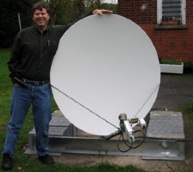
Solutions - VSAT Equipment
C band and Ku band
Satellite communications relies on RF (radio frequency) transmissions to work. There are two common satellite frequency bands: C band and Ku band. Each has its place.
Ku band generally uses smaller dish antennas (usually 1.2-1.8m) that are lower cost and easier to transport, but Ku transmissions are absorbed by rain. "Rain fade" causes the connection to slow right down or even to stop during heavy rainfall. Ku is therefore not ideal for use in high rainfall areas. Ku signal footprints also tend to be smaller, concentrated on major centers of population and may not therefore be as widely available as C band.
C band typically uses slightly larger antennas (1.8-2.4m). However, the signal is generally available to a larger area and the signal is not affected by rain.
Technology platform
After thoroughly researching the market, DRASTIC decided to use the iDirect platform exclusively for shared access service. This has substantial throughput advantages over competing platforms because it was designed from the ground up specifically for Internet traffic, whereas many competitors have tried to adapt technology which was designed mainly for broadcasting. If you want to know more, the paper "DVB (Digital Video Broadcast) vs. iDirect Technology" would be a good starting place.
Components
The selection of components that we make for your needs is based on:
a.) The location of your site. This will determine the signal strength which is available from the satellites that we use. We perform complex "link budget" calculations that tell us what antenna and transmitter specifictions are necessary to ensure good performance.
b.) Logistical considerations. For example, if you need to get an antenna into a small aircraft for transport to the operational site, we will recommend the most suitable model.
The principal components of the VSAT system are:
The dish antenna or reflector.
DRASTIC most commonly use 1.2-1.8m antennas for Ku band service and 1.8-2.4m antennas for C band service. We will normally specify anennas from Prodelin or Patriot. We can sometimes also convert existing VSAT antennas for use with our services.

Prodelin 1.2m antenna
Antenna Mount
Antenna mounts come in a variety of styles for different applications in different locations. The most common is a pole mount, where the pole on which the antenna is mounted is set into a substantial concrete block in the ground. (Also known as a penetrating mount). On flat roof surfaces, where penetration would compromise the building, a Non Penetrating Roof Mount (NPRM) is used, as shown above. This relies on balast to keep the dish from moving. Custom mounts can also be constructed to fix an antenna to walls, balconies and the like. The mount required is determined, based on a site survey, which can often be conducted by the customer.
Indoor Electronics.
The VSAT modem we normally specify is the iDirect 3100.
![]()
iDirect Infinity 3100 VSAT modem
Outdoor Electronics.
The outdoor electronics are mounted on the antenna. They handle transmission and reception of the signal to and from the satellite. The transmitter (BUC) is normally rated 2-8W for Ku band services and 5-20W for C band.

Outside electronics on a C band system
We currently specify receivers (LNB) or the higher precision PLL type for C band service, as these have proven to be much more reliable than the cheaper DRO type.
IFL Cable
The cable runing from the outdoor electronics on the antenna to the VSAT modem is known as the IFL cable. We specify Quad shield cable and use high quality connectors to minimize signal loss.
Earthing and lightning protection
It is vital to protect VSAT equipment from damage due to electrical surges and lightning. DRASTIC provide an installation kit with high quality earthing and lighning protection components.
© Copyright DRASTIC, 2005-2006